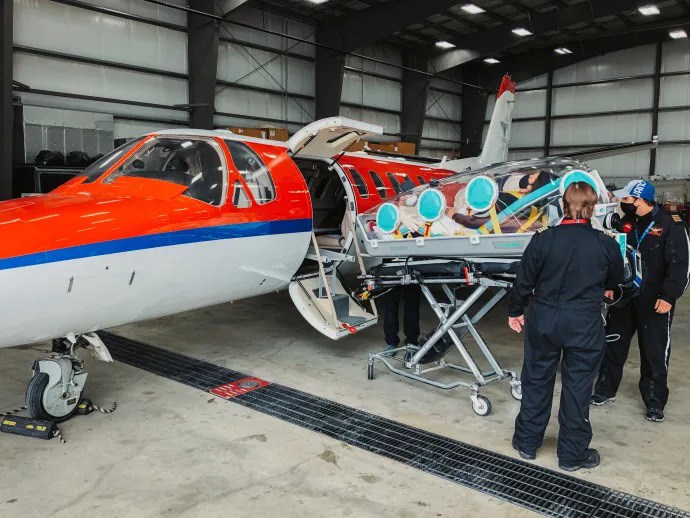The past week Keewatin Air staff and hospital staff at the Health Sciences Centre’s simulation lab and Stretcher Service of Manitoba have gone through extensive training including trial runs in using the EpiShuttle.
“We now have operational certification from Transport Canada to deploy single-patient isolation and transport units, called EpiShuttles in our Pilatus PC-12 planes. Keewatin, along with Alberta Health Services fixed wing air ambulance has EpiShuttles operating,” says Janet Busse, Executive Director of Medical Operations at Keewatin Air.
In case of a local outbreak, Keewatin Air can, with their EpiShuttles, offer fast transport, even from remote locations. The aircraft PC-12 is widely used in the north where its short takeoff and landing capabilities make it able to service the smallest remote communities with modest airstrips. This includes missions to Alert, the most northerly community in Canada and the world (800 miles from the North pole).
According to a Nov. 11 press release from EpiGuard, Keewatin Air is a subsidiary of a group of airlines owned by Exchange Income Corporation. With that, Keewatin Air is also working on certificates to do mass evacuations with EpiShuttles in ATRs and Dash 8s as well.
In hotspots with COVID-19 outbreaks, patients may need transport to places with available ICU capacity.
“The EpiShuttle allows patient monitoring and full intensive care treatment during transport, including emergency procedures like intubation and insertion of central venous catheters. In addition, for COVID-19 patients, the adjustable backrest is extremely important to keep coughing at a minimum. However, it was the fact that the EpiShuttle is re-usable, making it the most cost-efficient product on the market, which made us decide on the EpiShuttle,” says Busse.
EpiGuard CEO Ellen Cathrine Andersen says, “An ambulance usually requires 2-4 hours of disinfection between every infectious transport, and with an entire aircraft, it can take almost a full day. Disinfection puts transport vessels out of play, and in case of exposure, a whole team can be grounded for days. The pandemic compromises the entire medivac system.” EpiShuttle provides airtight single patient isolation and transport.
EpiGuard is a Norwegian company established in 2015 to provide safe transportation of contagious patients. Five major Air-Forces have already purchased the EpiShuttle as well as ground ambulance services, private air transport companies and hospitals.
ABOUT Nunavut
Nunavut extends from the borders of eastern Northwest Territories and northern Manitoba to the southern border of Kitikmeot region, just above the Arctic Circle. It adjoins Baffin region to the northeast.
Keewatin on the northwest coast of Hudson Bay was named from the Cree Indian word for “north wind,” and is largely a permafrost zone with Arctic tundra vegetation.
The major settlements (Arviat, Baker Lake [Qamanittuaq], and Rankin Inlet [Kangiqtinq; the regional headquarters]), are economically dependent upon fur trapping, sealing, copper and gold mining, and handicrafts. The population is mostly Inuit. Pop. (2011) 8,348. From Britannica: https://www.britannica.com/place/Keewatin




